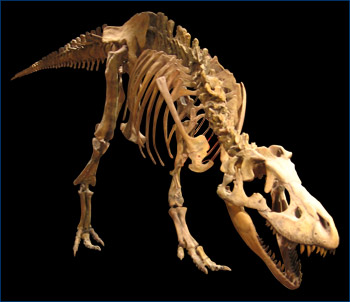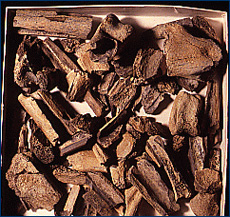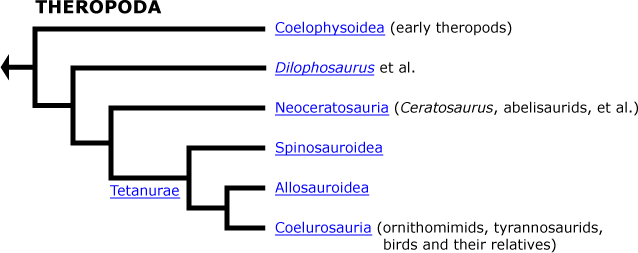
Tarbosaurus skeletal mount at the Mesa Southwest Museum.
Theropoda
 Tarbosaurus skeletal mount at the Mesa Southwest Museum. |
|
The theropod (meaning "beast-footed") dinosaurs are a diverse group of bipedal saurischian dinosaurs. They include the largest terrestrial carnivores ever to have made the earth tremble. What most people think of as theropods (e.g., T. rex, Deinonychus) are extinct today, but recent studies have conclusively shown that birds are actually the descendants of small nonflying theropods. Thus when people say that dinosaurs are extinct, they are technically not correct. Still it's not as exciting seeing a sparrow at your bird feeder as it would be to see a Tyrannosaurus rex there.
Our knowledge of the evolutionary history of the Theropoda is constantly under revision stimulated by new, exciting fossil finds every year or so such as Mononykus olecranus, a very bird-like theropod found in the Mongolian desert, or Giganotosaurus carolinii, a giant theropod probably rivaling the size of T.rex., found recently in Argentina. In fact, the 1960's discovery and study of the remains of Deinonychus antirrhopus helped to revise paleontology's old vision of all dinosaurs as slow, stupid reptiles, and was a key factor in the onset of the controversial hot-blooded/cold-blooded debate. Currently, there are two or three main groups of theropods, depending on whom you ask; we have yet to fully understand their origin. Why is this so? The main reason is the lack of good specimens; theropod remains are fairly rare and more often than not, fragmentary — theropods have a poor fossil record compared to most of the ornithischian dinosaurs. Fossils of small theropods are especially rare, since small bones are harder to find and are weathered away easily. Without well-preserved, complete specimens, it is hard to tell who is most closely related to whom using cladistics.
|
|
 |
Several characters that typify a theropod: hollow, thin-walled bones are diagnostic of theropod dinosaurs. A jumbled box containing theropod bones (from the UCMP collections) is shown at right. The hollow nature of the bones is certainly more obvious in 3D, but you should at least be able to make out the general tubular structure of the bones. Other theropod characters include modifications of the hands and feet: three main fingers on the manus (hand); the fourth and fifth digits are reduced; and three main (weight-bearing) toes on the pes (foot); the first and fifth digits are reduced. Most theropods had sharp, recurved teeth useful for eating flesh, and claws were present on the ends of all of the fingers and toes. Note that some of these characters are lost or changed later in theropod evolution, depending on the group in question.
Theropod classification
Let's take a look at the major groups of theropods ….

Theropod relationships are in a constant state of flux — new finds and analyses are frequently overturning old ideas. The cladogram for Theropoda has undergone considerable change since this page was first posted in 1993.
The Coelophysoidea were primarily small, bipedal carnivores that lived during the Late Triassic and Early Jurassic. The position of Dilophosaurus within Theropoda continues to be uncertain — some still consider it to be a large coelophysoid. Neoceratosauria includes Ceratosaurus, the Abelisauridae (e.g., Carnotaurus), and a few other dinosaurs whose relationships are still being debated.
The largest group of theropods is the Tetanurae, consisting of three major clades (sister taxa): the Spinosauroidea (Afrovenator, Torvosaurus, Baryonyx, Suchomimus, Irritator et al.); the Allosauroidea (Sinraptor, Carcharodontosaurus, Giganotosaurus, Acrocanthosaurus, Allosaurus, et al.); and the Coelurosauria (Compsognathus, Sinosauropteryx, Ornitholestes, Deinonychus, Tyrannosaurus, Archaeopteryx, birds, et al.).
The Coelurosauria were generally small (not counting a few tyrannosaurids), but quite diverse. It is interesting to note that feather-like structures have been found in fossils representing all coelurosaur subgroups except ornithomimids … so far! It truly is remarkable when you stop to consider that T. rex and hummingbirds are very close relatives — but the evidence is there in the fossil record.
Original page created by Rob Guralnick 11/1993, with later modifications by Allen Collins, Tony Fiorillo, Ben Waggoner and John Hutchinson; modifications since 2005 by David Smith. Tarbosaurus photo © Geb Bennett.